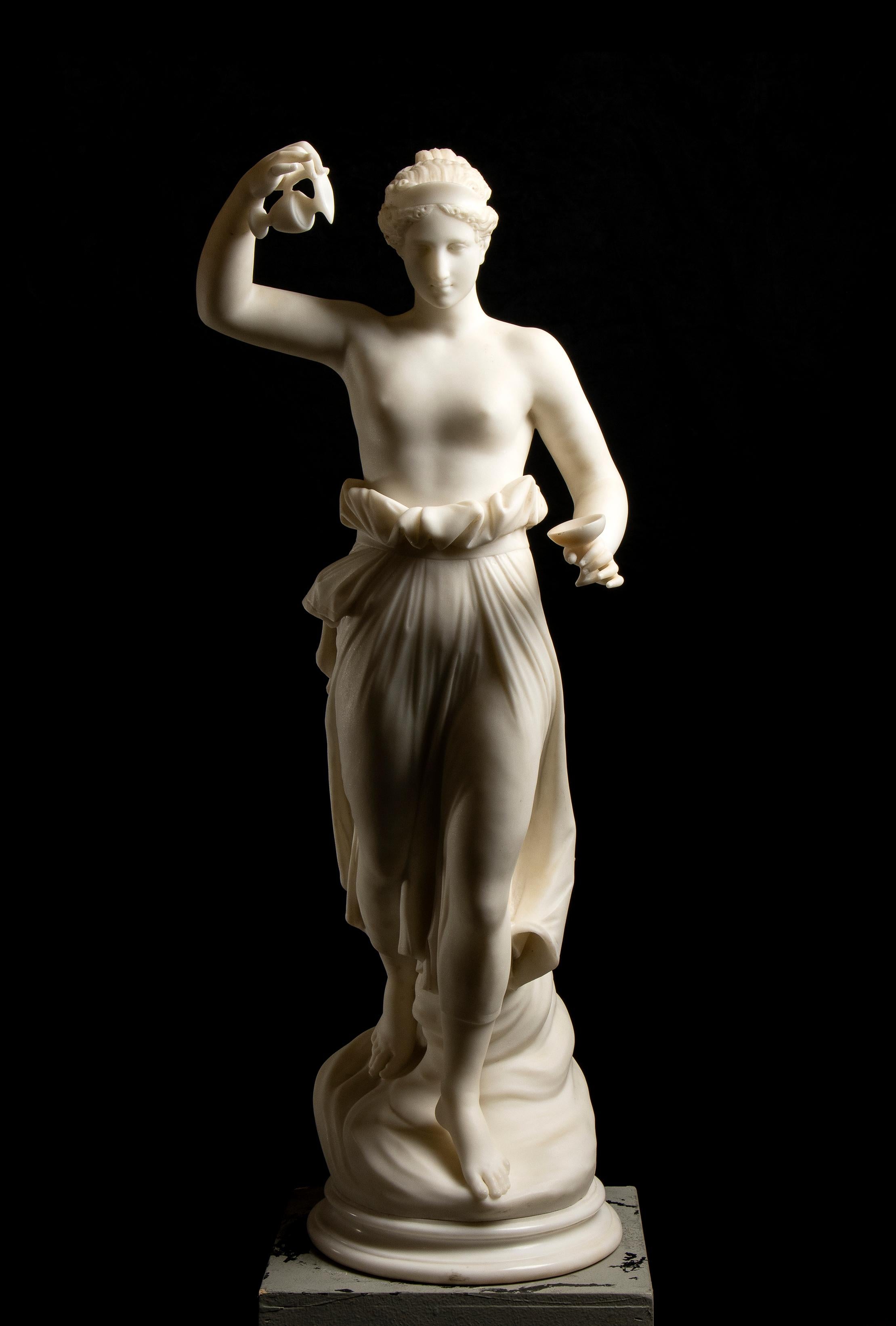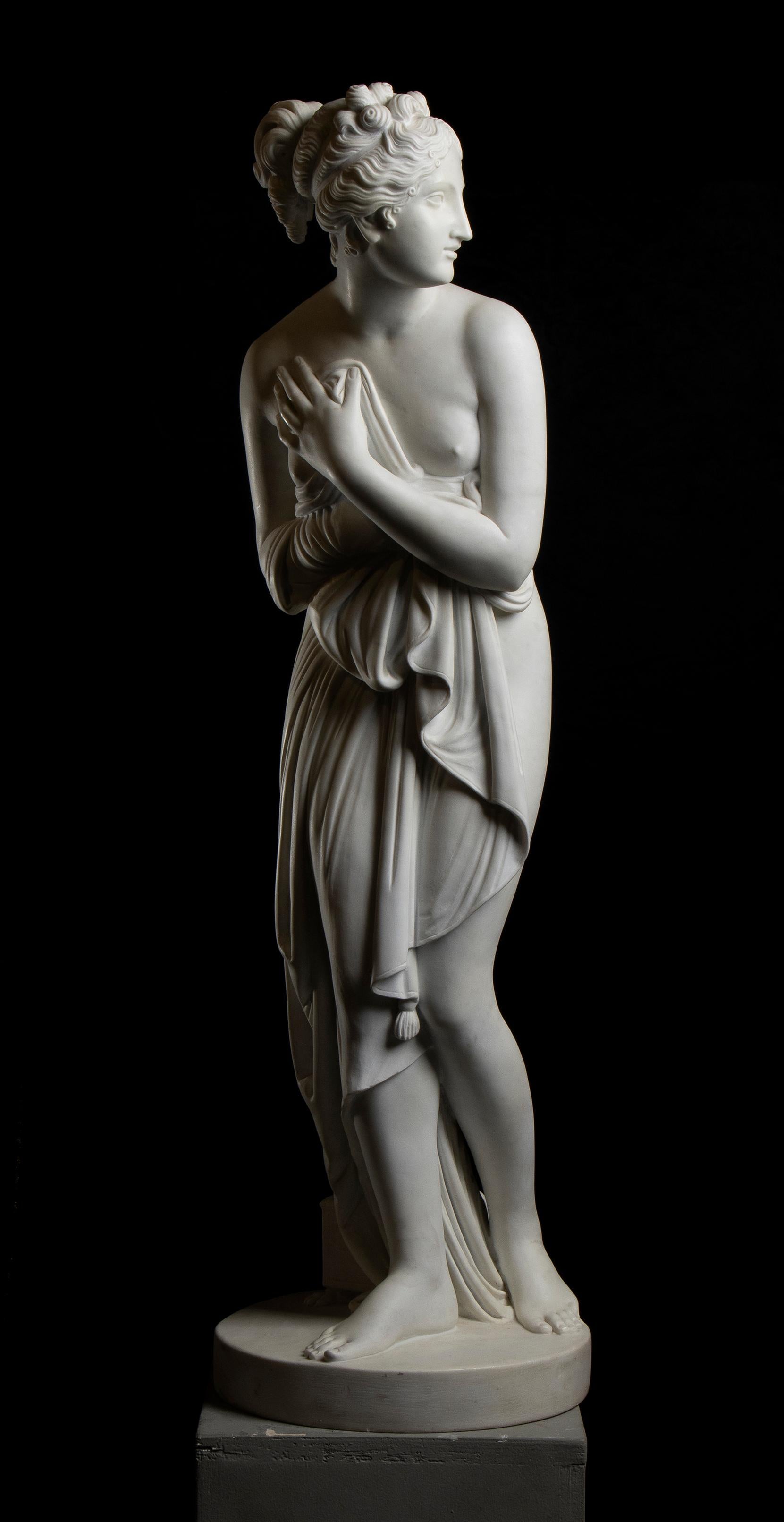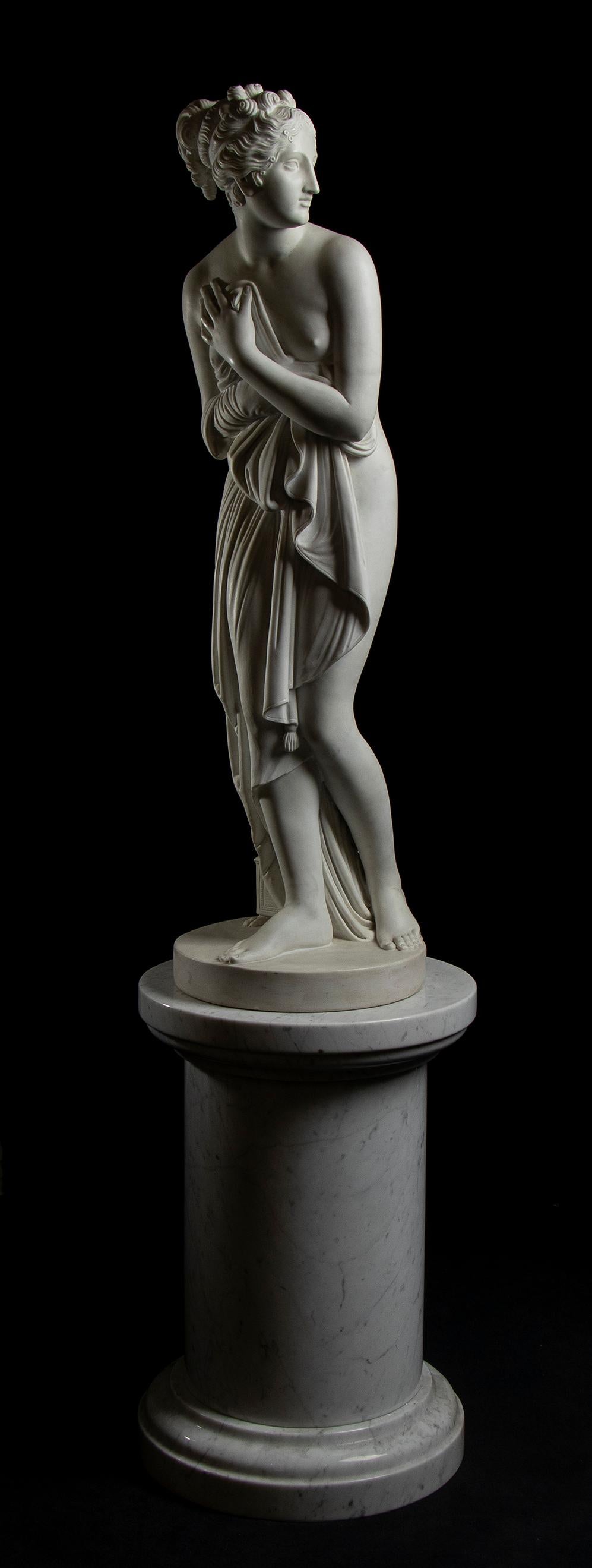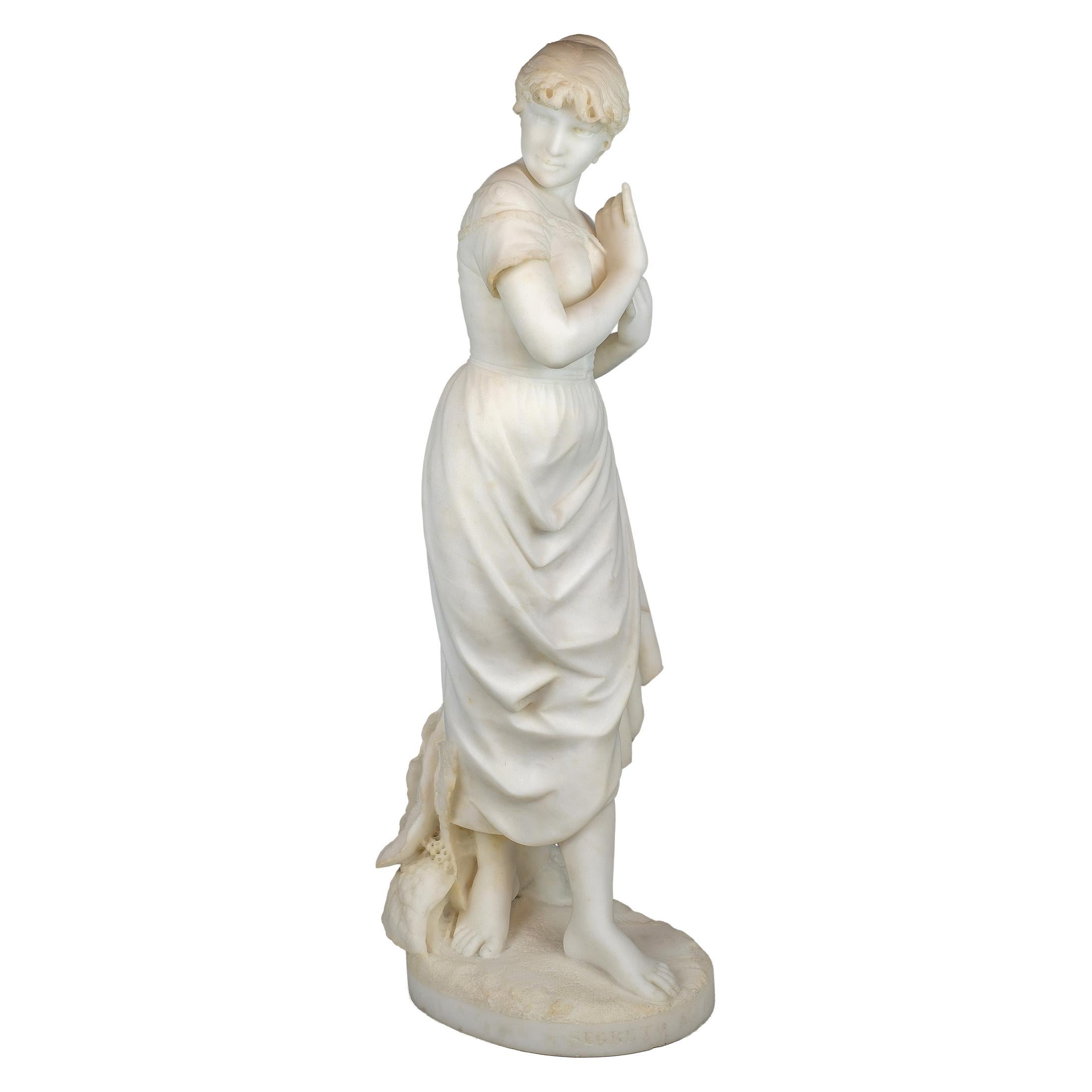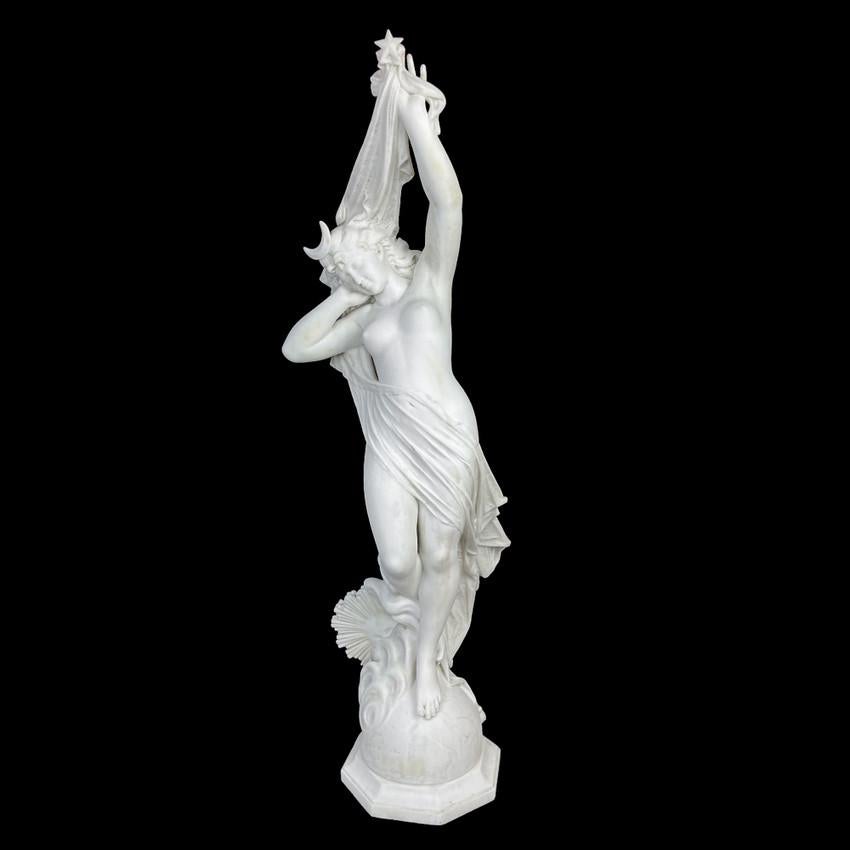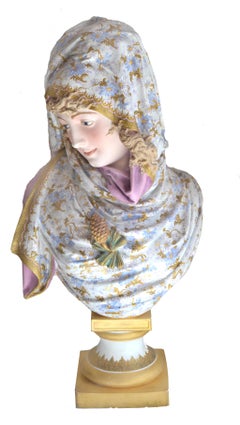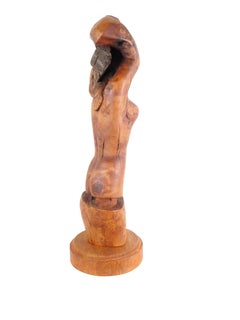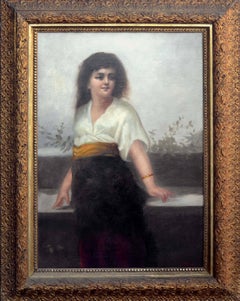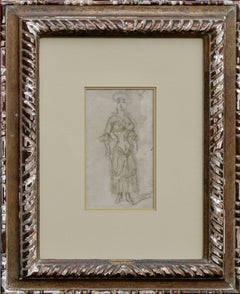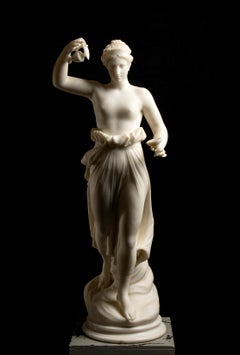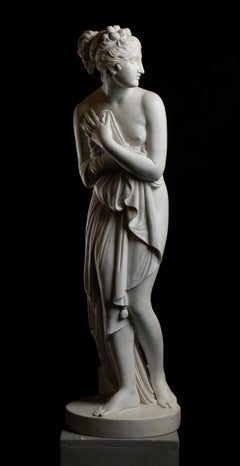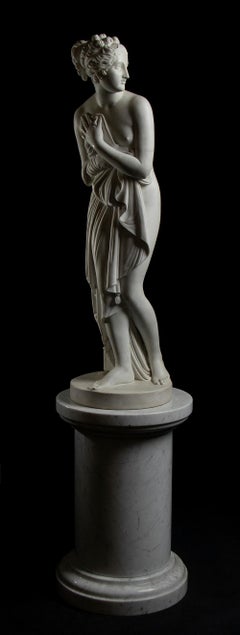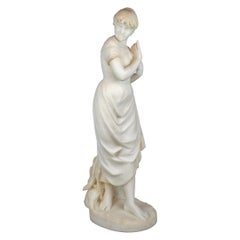Items Similar to NYDIA, THE BLIND FLOWER GIRL OF POMPEII Marble Sculpture 1856-1870
Want more images or videos?
Request additional images or videos from the seller
1 of 21
Randolph John RogersNYDIA, THE BLIND FLOWER GIRL OF POMPEII Marble Sculpture 1856-18701856-1860
1856-1860
$15,000
£11,389.86
€13,025.15
CA$20,957.18
A$23,308.95
CHF 12,171.21
MX$283,645.17
NOK 155,444.94
SEK 145,779.93
DKK 97,211.69
Shipping
Retrieving quote...The 1stDibs Promise:
Authenticity Guarantee,
Money-Back Guarantee,
24-Hour Cancellation
About the Item
Randolph John Rogers (American, 1825 - 1892) Randolph Rogers' Nydia, the Blind Flower Girl of Pompeii debuted in 1856 to critical and public acclaim, solidifying Rogers’ position as a pre-eminent American sculptor and it remains one of the artist’s most celebrated works today. The subject of Nydia is drawn from Edward Bulwer-Lytton's The Last Days of Pompeii 1834. After touring the ruins of the ancient city in 1833, and inspired by the stories of blinding volcanic ash, he composed the tale of Nydia, a slave who led her master, Glaucus, to safety. Rogers depicts Nydia at the moment that she and Glaucus have become separated in their perilous journey through the rubble and Nydia seeks familiarity in the surrounding chaos, her distress evident in her pained expression. The grace of the sculpture is at odds with the turmoil portrayed; a toppled Corinthian capital lies at her feet and obstructs her next step, indicated by the tilt of her back foot and grip on her walking stick. Examples of this model can be found in major American collections, including The Metropolitan Museum of Art, the Art Institute of Chicago, the Detroit Institute of Arts, the Los Angeles County Museum of Art, and the Museum of Fine Arts, Boston.
Literature, Millard F Rogers, Jr. Randolph Rogers, American Sculptor in Rome. University of Massachusetts Press, 1971, American Figurative Sculpture in the Museum of Fine Arts Boston. Museum of Fine Arts, Boston, 1986. Joyce K Schiller. "Nydia, A Forgotten Icon of the Nineteenth Century." Bulletin of the Detroit Institute of Arts,
Born in Waterloo, New York, Randolph John Rogers became an expatriate* sculptor of idealized figures, portraits, and commemorative works in Neo-Classical* and Realist* styles. He worked in clay, plaster, marble and bronze, and lived both in Italy and the United States. He made 167 examples of Nydia in two sizes (varies depending on base height) 36" and 54'.
Rogers was raised in Ann Arbor, Michigan, and as a young man did woodcuts* for the local newspaper, The Michigan Argus, and also worked as a baker's assistant and a dry goods clerk. In 1847, he moved to New York City, where he hoped to find work as an engraver*, but failing to do so, worked in a dry goods store owned by John Steward, Jr., and Lycurgis Edgerton. Impressed by his talents at drawing and modeling, they paid for him to go abroad. He left in the fall of 1848, going first to Florence where he began study in 1848 with Lorenzo Bartolini at the Accademia di Belle Art*. He became skilled at modeling in clay and plaster but did not learn to carve marble until later.
In 1851, he established a studio in Rome, and, although he returned occasionally to America, he, "over the next several decades, was a pillar of American expatriate artist life." . Assuring his success was his modeling of Nydia, the Blind Flower Girl of Pompeii. Many replicas were made, and reportedly it rivaled Prosperine by Hiram Powers in numbers of copies. Having become proficient at marble, Rogers carved busts for many persons who visited his studio.
In 1858, he returned to America for his first public commission, which was a life-size statue of John Adams for Mount Auburn Cemetery chapel in Cambridge, Massachusetts. (The statue is now at Harvard University in Memorial Hall). Rogers worked out of his studio, which was in the National Academy of Design. He got a second commission, having lobbied successfully, for a set of doors at the U.S. Capitol building, which are now at the central portico of the Rotunda's east facade. They represent the life of Christopher Columbus. Rogers also finished an equestrian memorial of George Washington, which had been in progress by Thomas Crawford when he died in 1857.
In the 1860s and 1870s, he was highly prolific. His work included religious and literary subjects such as Isaac from the Old Testament, and Fasti from Ovid, which received over 100 orders for replicas. He modeled the Angel of the Resurrection in memory of Samuel Colt, the arms manufacturer, for his burial spot at Cedar Hill Cemetery in Hartford, Connecticut. In 1877, for the dome of the capitol building at Hartford, he did a figure, destroyed in 1938, The Genius of Connecticut. In Cincinnati, as well as Providence, Rhode Island, Detroit, and Worcester, Massachusetts, he did formula post-Civil War monuments.
Among his portrait statues are Abraham Lincoln 1871 for Fairmount Park in Philadelphia; and William Seward 1876 for Madison Square in New York City.
Living most of the most productive time of his career in Rome, he was elected an "academician of merit" and resident professor of sculpture in 1873 to the Accademia di San Luca*, the oldest art academy in the world. He was the first American to receive these honors. In 1884, the Italian government named him a Knight of the Crown of Italy. Two years before that, Randolph Rogers suffered a debilitating stroke, but he continued to supervise production of his sculptures.
- Creator:Randolph John Rogers (1825 - 1892, American)
- Creation Year:1856-1860
- Dimensions:Height: 36 in (91.44 cm)Width: 19 in (48.26 cm)Depth: 20 in (50.8 cm)
- Medium:
- Movement & Style:
- Period:
- Condition:180 examples were made from 1852-60, records, prices $28,000 and up. Weathered surface and numerous chips to marble edges (nose, base dress) Arm is broken and in 4 pieces (unattached) missing fingers parts, top of staff is missing. Restoration needed.
- Gallery Location:Soquel, CA
- Reference Number:Seller: RJA6389*1stDibs: LU54212637182
About the Seller
5.0
Platinum Seller
Premium sellers with a 4.7+ rating and 24-hour response times
Established in 1986
1stDibs seller since 2014
2,958 sales on 1stDibs
Typical response time: <1 hour
- ShippingRetrieving quote...Shipping from: Soquel, CA
- Return Policy
Authenticity Guarantee
In the unlikely event there’s an issue with an item’s authenticity, contact us within 1 year for a full refund. DetailsMoney-Back Guarantee
If your item is not as described, is damaged in transit, or does not arrive, contact us within 7 days for a full refund. Details24-Hour Cancellation
You have a 24-hour grace period in which to reconsider your purchase, with no questions asked.Vetted Professional Sellers
Our world-class sellers must adhere to strict standards for service and quality, maintaining the integrity of our listings.Price-Match Guarantee
If you find that a seller listed the same item for a lower price elsewhere, we’ll match it.Trusted Global Delivery
Our best-in-class carrier network provides specialized shipping options worldwide, including custom delivery.More From This Seller
View AllAfter Albert-Ernest Carrier Belleuse Bisque Plotchrome Persian Maiden
By Albert-Ernest Carrier-Belleuse
Located in Soquel, CA
Bisque bust with ploychrome enamel decorated with painted gilt and raised on a circular socle with a square plinth. After Albert-Ernest Carrier-Belleuse by Ferdinand and Bing Co. an ...
Category
Early 1900s Aesthetic Movement Figurative Sculptures
Materials
Enamel
Burled Maple Sculpture Nude Woman with Arms Over Head and Stone
Located in Soquel, CA
Burled Maple Sculpture Nude Woman with Arms Over Head
Beautiful burled walnut sculpture of a nude woman. The woman stands with her arms stretched over her head. Behind her a dark st...
Category
Mid-20th Century Post-War Figurative Sculptures
Materials
Stone
Girl with the Gold Sash, Late 19th Century Large-Scale Female Figurative
By Eduardo Tojetti
Located in Soquel, CA
Girl with the Gold Sash, Late 19th Century Large-Scale Female Figurative
Late 19th century Romanic portrait of a young girl by Eduardo Tojetti (American/Italy, 1851-1930), c.1880. T...
Category
19th Century Victorian Figurative Paintings
Materials
Oil, Linen
1860s Drawing L'Amazon Figurative
By Constantin Ernest Adolphe Hyacinthe Guys
Located in Soquel, CA
Antique pencil and faded watercolor wash portrait titled "L'Amazon" (French, translates "horsewoman") by Constantin Guys (French, 1802-1892), circa 1860...
Category
1860s Victorian Figurative Drawings and Watercolors
Materials
Watercolor, Rag Paper, Pencil
19th Century Italian School Portrait of Peasant Girl
Located in Soquel, CA
Charming 19th Century Italian School portrait of peasant girl by unknown artist, circa 1840. Partial signature lower right edge. Condition: fai...
Category
1850s Italian School Portrait Paintings
Materials
Linen, Oil
Athenian Woman Carrying a Water Jar In a White Dress
Located in Soquel, CA
Athenian Woman Carrying a Water Jar In a White Dress
Beautiful painting by a Central California artist circa 1890s (American 19th c). Oil painting of a Athenian woman holding a blue water vase on her shoulder with a red and orange shawl draped over her white dress. Painted on late 19th century Academy...
Category
1890s Impressionist Paintings
Materials
Masonite, Oil
You May Also Like
Antonio Canova Ebe Aprés Ebe White Marble Sculpture 19th Century Italian
By Antonio Canova
Located in Roma, IT
An important grand tour Antonio Canova Ebe (Aprés), carved in white marble by an Italian sculptor artist in the 19th century from a block of white marble.
The work depicts the go...
Category
19th Century Other Art Style Figurative Sculptures
Materials
Marble
Antonio Canova (After) Marble Sculpture Of Venus Italica Uffizi Museum 19th
By Antonio Canova
Located in Roma, IT
a superb scale size of the Venere italica, the famous and notable sculpture carved by Antonio Canova in the 19th century. At the top of his notability and influence the King Ludovico...
Category
19th Century Other Art Style Figurative Sculptures
Materials
Marble
Antonio Canova (After) Marble Sculpture Of Venus Italica On Marble Base
By Antonio Canova
Located in Roma, IT
a superb scale size of the Venere italica, the famous and notable sculpture carved by Antonio Canova in the 19th century standing on circular Carrara marble base.
At the top of his ...
Category
19th Century Other Art Style Figurative Sculptures
Materials
Marble
Italian Marble Statue of a Young Maiden by Cesare Lapini
Located in New York, NY
CESARE LAPINI
Italian, (1848-1893)
Segreto Al Cuore
Signed Prop ta Fratelli; Lapini; Firenze
29 1/4 x 8 x 11 inches
Notes:
A fine quality white marble sculpture of a you...
Category
Late 19th Century Figurative Sculptures
Materials
Marble
FERDINANDO VICHI 1875-1945 Selene Female Figural Marble Statue .
By Ferdinando Vichi
Located in New York, NY
A charming allegory for Dawn
Date: 19th Century
Origin: Italian
Material: Carrara Marble
Signed F. Vichi , Firenze.
Dimensions: 41" H x 10" Diameter
A spellbinding female figural...
Category
19th Century Figurative Sculptures
Materials
Marble
"La Danza", Grande scultura in Marmo bianco di Carrara XIX secolo
By Antonio Giovanni Lanzirotti
Located in Pistoia, IT
Antonio-Giovanni Lanzirotti, "La Danza", grande scultura in marmo bianco di Carrara, firmata AG Lanzirotti sulla base.
Antonio Giovanni Lanzirotti, nato a Palermo il 9 maggio 1839 e...
Category
1860s Italian School Figurative Sculptures
Materials
Marble
More Ways To Browse
Sculpture Of Flowers
Bronze Flower Sculptures
Girl Sculpture Young
The Resurrection
Italy Clay Sculptures
Stick Sculpture
Marble Flower Sculpture
Marble Girl
Marble Feet Sculpture
1850 Bronze Sculpture
Plaster Flower
Life Size Plaster Sculpture
Neo Classical Sculpture
Bronze Girls Bronze Marble
Black Man Bust
Italian Religious Icon
Angel Marble
Angel Statue
